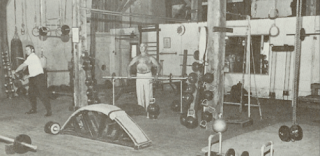I hope to shed some light on what made the Old School so good...and what should have been corrected, based on my observations.
The BAD... Dude, where's my squat?
One thing that leaps out at anyone who goes from "new" school to "old" school is how the now-ubiquitous squat was so often M.I.A from so many strength training literature. It doesn't pop up much until the late 1920's and early 1930's. The most notable mention of the squat I heard before was from Bert Asirati and Henry Steinborn in the 1920's. Despite it's overwhelming acceptance as a necessary strength training movement now, it's still got a few detractors that consider it a knee-wrecker. How did this whole thing happen?
I've seen some pictures in various training sources that may shed some light on what was wrong then and how it still haunts the ignorant about the squat now. One involved an old picture demonstrating how to Hack Squat. I'm sure that my readers are well-aware of the fact that Hack Squats started out as a barbell movement which the iron game history credits the great George Hackenschmidt with developing...NOT A MACHINE-BASED MOVEMENT!
Slap yourself if you didn't know that. Then you can continue reading...
Back then, the squat was also known as the deep knee bend. Nowadays we're advised to think of squatting less like a knee movement and more along the lines of a, "hips back, chest proud", movement. Any nomenclature calling a squat a knee bend was probably a bad name but it describes pretty well what people 100 years ago were doing. I wouldn't make a habit of doing too many of these. I'm not surprised that so few did either.
I was surprised to learn that the squat that we know of now was more of a European phenomenon that this source credits the Immortal Henry "Milo" Steinborn with popularizing: heels down, more of a butt-back than knees-forward movement.
 |
| Things were getting better. I didn't have the heart to crop the old leg press picture. I wouldn't do that but it's still pretty nifty! |
Antique TRX?
One thing that they did get horribly right back when the old-timers were getting the squat horribly wrong was the ample use of rope and rings in the gyms for upper body strength. This made a lot of sense since weights were still ridiculously expensive and a lot of the strongmen came from gymnastic or acrobat backgrounds. Regardless of whether it was an issue of frugality or familiarity, it was still a great choice because it's entirely possible to make a superbly-powerful upper body with such simple implements.
Around the time we got things straightened out with the squat was also the time that the cost of weights began coming a bit more down to earth and the ropes and rings slowly came off the rafters at hardcore gyms. It's been a long road to get them back into serious gyms these days. Too often the reincarnations have been the ridiculously-overpriced TRX and the ropes get flailed on the ground rather than hung from ceilings in a dignified manner. Still, they have their place and they're still solid strength training tools.
See Anything Else Missing Above?
Are kettlebells really, "old school", and "functional" because they're old and they mimic all sorts of real life work and sport situations? Or, are they more practical than a lot of other training tools because they're kind of awkward and they are almost always lifted off the ground? I still insist on replacing the term, "functional," with, "practical." If you want to make your strength training practical and far more relevant to real life endeavors of life, then start out with nearly everything on the ground and if you want it off the ground, lift it up off yourself.
Very few things in life are as nicely balanced as a barbell and it's rarely put on a nice rack for you to access it better by one movement. No, chances are it's below your knees, weird shaped, and requires two or three different movements to get it to where you want it to go. While you do loose some bragging rights with the poundages you lift by conveniently putting the weight at a spot where you can lift it in a rack or cage, you also gain the ability to lift in manners that will help in real life.
Conveniently, these three points about the old days nicely encapsulate what my pre-sprained knee training was all about: Heavy emphasis on BW-based upper body movements combined with weight-based squatting, with every weight-based movement starting off with the weight the ground. It's crude but it works as well now as it did back then.



No comments:
Post a Comment